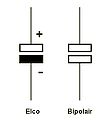Electronic symbol
An electronic symbol is a
Standards for symbols
The graphic symbols used for electrical components in circuit diagrams are covered by national and international standards, in particular:
- BS3939).
- There is also IEC 61131-3 – for ladder-logic symbols.
- JIC JIC (Joint Industrial Council) symbols as approved and adopted by the NMTBA (National Machine Tool Builders Association). They have been extracted from the Appendix of the NMTBA Specification EGPl-1967.
- ANSI Y32.2-1975 (also known as IEEE Std 315-1975[1] or CSA Z99-1975).
- IEEEStd 91/91a: graphic symbols for logic functions (used in digital electronics). It is referenced in ANSI Y32.2/IEEE Std 315.
- Australian Standard AS 1102 (based on a slightly modified version of IEC 60617; withdrawn without replacement with a recommendation to use IEC 60617).
The number of standards leads to confusion and errors.[2] Symbols usage is sometimes unique to engineering disciplines, and national or local variations to international standards exist. For example, lighting and power symbols used as part of architectural drawings may be different from symbols for devices used in electronics.
Common electronic symbols
Symbols shown are typical examples, not a complete list.[3][4]
Traces

Grounds
The shorthand for ground is GND. Optionally, the triangle in the middle symbol may be filled in.
-
Signal/low-noise ground (the asterisk is not part of the symbol)
-
Chassis ground
(IEC-style)
Sources
-
Battery, single-cell
-
Battery, multi-cell
-
Solar cell (photovoltaic cell)
-
DC voltage source
-
Controlled DC voltage source
-
Current source
-
Controlled current source
-
AC voltage source
Resistors
It is very common for
-
-
IEC-style: (a) Resistor, (b) Rheostat,
(c) Potentiometer / Trimmer
-
Photoresistor (ANSI)
-
Varistor (ANSI)
Capacitors
-
General capacitor
(IEC-style) -
Polarized capacitor
(American-style), such as electrolytic and tantalum capacitors -
Variable capacitor
-
Trimmer variable capacitor
Diodes
Optionally, the triangle in these symbols may be filled in. Note: The words anode and cathode typically aren't part of the diode symbols.
-
Diode (rectifier)
-
Light-emitting diode (LED)
-
Silicon-controlled rectifier(SCR)
-
Diac(may be a varistor in older schematics)
-
Opto-isolator: LED (left), photo transistor (right)
Bridge rectifiers
There are many ways to draw a single-phase bridge rectifier symbol. Some show the internal diode circuit, some don't.
-
Bridge rectifier
-
Bridge rectifier
-
Bridge rectifier
-
Bridge rectifier
-
Three-phase bridge rectifier
Inductors
An inductor can be drawn either as a series of loops, or series of half-circles.
-
Inductor symbol as a series of loops
-
Magnetic-core inductor
(IEEE-style) -
Tapped inductor
(IEC-style) -
Ferrite bead
(IEEE-style) -
Variable inductor
-
Trimmer variable inductor
Transformers
-
Transformer with center tap on secondary winding (right side)
-
Transformer with two secondary windings (right side)
-
Zero-sequence current transformer (ZSCT) (also known as a window-type current transformer)
-
Bushing-type current transformer
-
Voltage transformer
Transistors
Optionally, transistor symbols may include a circle.[6] Note: The pin letters B/C/E and G/D/S aren't part of the transistor symbols.
Bipolar
-
NPN bipolar junction transistor(BJT)
-
PNP bipolar junction transistor(BJT)
-
NPNPhototransistor
Unipolar
-
Metal–oxide–semiconductor field-effect transistor(MOSFET)
-
Enhancement mode, N-channel MOSFET
-
Enhancement mode, P-channel MOSFET
Vacuum tubes
-
Vacuum tube diode
-
Vacuum tube triode
-
Vacuum tube tetrode
(pin letters are not part of the symbol) -
Vacuum tube pentode
Switches
For multiple pole switches, a dotted or dashed line can be included to indicate two or more switch at the same time (see DPST and DPDT examples below).
-
Pushbutton, normally open, push-to-make (horizontal line on top)
-
Pushbutton, normally open, push-to-make (IEEE-style)
-
Pushbutton, normally closed, push-to-break (IEEE-style)
-
Pushbutton, normally closed, two circuits (IEEE-style)
-
Switch, 1P1T, SPST (single-pole single-throw)
-
Switch, 1P2T, SPDT (single-pole double-throw)
-
Switch, 2P1T, DPST (double-pole single-throw)
-
Switch, 2P2T, DPDT (double-pole double-throw)
-
Slide switch, 1P3T,
break-before-make, nonshorting style -
Slide switch, 1P4T,
break-before-make, nonshorting style -
Slide switch, 1P4T,
make-before-break, shorting style
-
Rotary switch, 1P3T,
break-before-make, nonshorting style -
Rotary switch, 1P4T,
break-before-make, nonshorting style -
Rotary switch, 1P4T,
make-before-break, shorting style
-
Reed switch, normally open
Relays
Relays symbols are a combination of an inductor symbol and switch symbol.
Note: The pin letters in these symbols aren't part of the standard relay symbol.
-
SPST, SPDT, DPST, DPDT relays
(American-style) -
SPDT relay
(IEC-style)
Lamps
LED is located in diode section.
-
Indicating lamp
(IEEE-style) -
Incandescent lamp
-
Incandescent light bulb (as an indicator)
-
Light bulb
Current limiters
-
Molded-case circuit breaker (MCCB)
Electro-acoustic devices
Speaker symbols sometimes include an internal inductor symbol.
-
Loudspeaker
(IEEE-style) -
Buzzer
(IEC-style) -
Microphone
(IEEE-style) -
Microphone
(IEC-style)
Antennas
-
General antenna
(IEC-style) -
Dipole antenna
(IEC-style) -
Loop antenna
(IEC-style) -
Loop antenna
(IEEE-style)
Cables
-
Cable, Shielded 1 conductor
-
Cable, 2 conductor
-
Cable, Shielded 2 conductor with shield connected to ground
-
Cable, 5 conductor
-
Cable, Shielded 5 conductor
Connectors
There are numerous connector symbol variations.
-
TRS phone jacks
-
UEXT connector based on a 5x2 shrouded header with notch key
ICs
Logic gates
For the symbols below: A and B are inputs, Q is output. Note: These letters are not part of the symbols.
There are variations of these logic gate symbols. Depending on the IC, the two-input gates below may have: 1) two or more inputs; 2) infrequently some have a second inverted Q output too.
-
Buffer
-
Inverter (NOT)
The above logic symbols may have additional I/O variations too: 1)
-
Buffer gate with schmitt trigger input
-
Buffer gate with tri-state output control.
(B is the tri-state control)
Flip-flops
For the symbols below: Q is output, Q is inverted output, E is enable input, internal triangle shape is clock input, S is Set, R is Reset (some datasheets use clear (CLR) instead of reset along the bottom).
There are variations of these flip-flop symbols. Depending on the IC, a flip-flop may have: 1) one or both outputs (Q only, Q only, both Q & Q); 2) one or both forced inputs along top & bottom (R only, S only, both R & S); 3) some inputs may be inverted.
-
Simple SR flip-flop (inverted S & R inputs)
-
Gated SR flip-flop
-
Gated D flip-flop (Transparent Latch)
-
Clocked D flip-flop
(Set & Reset inputs) -
Clocked JK flip-flop
-
Clocked T flip-flop
OpAmps
Note: The outside text isn't part of these symbols.
-
Operational amplifier (opamp)
Oscillators
-
Crystal oscillator
(IEEE-style) -
Ceramic resonator
(3 pins)
Miscellaneous devices
-
Hall-effect sensor
-
Gas-discharge tubes (GDT) for ESDdischarge
Historical electronic symbols
The shape of some electronic symbols have changed over time. The following historical electronic symbols can be found in old electronic books / magazines / schematics, and now considered obsolete.
Capacitors (historical)
All of the following are obsolete capacitor symbols.
-
Obsolete capacitor
(very old style) -
Obsolete capacitor
-
Obsolete capacitor
-
Obsolete capacitor
-
Obsolete capacitor
See also
References
- .
- ^ Guidelines for Drawing Schematics.
- ^ Circuit Symbols for all Electronic Components. Talking Electronics, 2013. Retrieved 01 Apr 2015.
- ^ Electrical Symbols & Electronic Symbols. RapidTables, 2012. Retrieved 17 April 2016.
- ^ "Standards for Resistor Symbols". EePower. EETech Media. Retrieved September 13, 2021.
- ^ "A4.11 Envelope or Enclosure". ANSI Y32.2-1975 (PDF). Archived from the original (PDF) on 2022-10-09. Retrieved 2020-12-29.
The envelope or enclosure symbol may be omitted from a symbol referencing this paragraph, where confusion would not result
Further reading
- Standards
- IEC 60617 : Graphical Symbols for Diagrams; 2012.
- IEEE 315 : Graphic Symbols for Electrical and Electronics Diagrams (including Reference Designation Letters); 1975.
- U.S. DoD MIL-STD-806B : Graphical Symbols for Logic Diagrams; 1962. (RevB in 1962)
- Books
- Beginner's Guide to Reading Schematics; 4th Ed; Stan Gibilisco; McGraw-Hill, 224 pages; 2018; ISBN 978-1260031119.
- How to Read Schematic Diagrams; 5th Ed; Donald Herrington; Literary Licensing; 130 pages; 2011;
- How to Read Electronic Circuit Diagrams; 2nd Ed; Robert Brown, Paul Lawrence, James Whitson; Tab Books; 214 pages; 1988; ISBN 978-0830628803. (2ed in 1988)
- Engineer's Mini-Notebook : Schematic Symbols, Device Packages, Design and Testing; 1st Ed; Forrest M. Mims III; Radio Shack; 48 pages; 1988. (1ed in 1988)













![Thermistor (ANSI).[5] Use -t for NTC symbol. Use +t for PTC symbol.](http://upload.wikimedia.org/wikipedia/commons/thumb/e/e8/IEEE_315-1975_%281993%29_2.1.12.1.2.svg/120px-IEEE_315-1975_%281993%29_2.1.12.1.2.svg.png)










































































































